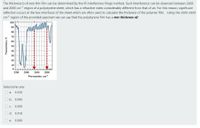
Chemistry
10th Edition
ISBN: 9781305957404
Author: Steven S. Zumdahl, Susan A. Zumdahl, Donald J. DeCoste
Publisher: Cengage Learning
expand_more
expand_more
format_list_bulleted
Concept explainers
Question
thumb_up100%
Give answer all questions with explanation please

Transcribed Image Text:The thickness b of very thin film can be determined by the IR interference fringe method. Such interference can be observed between 2800
and 2000 cm-1 region of a polystyrene sheet, which has a refractive index considerably different from that of air. For this reason, significant
reflection occurs at the two interfaces of the sheet which are often used to calculate the thickness of the polymer film. Using the 2000-2500
cm-1 region of the provided spectrum we can say that the polystyrene film has a mm thickness of:
100
90 M.
80
70
60
50
40
30
20
10
3200
2800
2400
2000
Wavenumber, cm-
Seleccione una:
O a.
0.030
O b. 0.045
O c. 0.090
O d. 0.018
O e. 0.060
Transmittance,
Expert Solution
This question has been solved!
Explore an expertly crafted, step-by-step solution for a thorough understanding of key concepts.
This is a popular solution
Trending nowThis is a popular solution!
Step by stepSolved in 2 steps

Knowledge Booster
Learn more about
Need a deep-dive on the concept behind this application? Look no further. Learn more about this topic, chemistry and related others by exploring similar questions and additional content below.Similar questions
- How many chiral carbons in the given structure?arrow_forwardhow many chiral senters are in this moleculearrow_forwardZwitterions are ...... amino acids with side-chain carboxylate anions. O delocalized ions O ions that bear both negatively and positively charged groups but have a net charge of zero. O amino acids. ionic molecules that have multiple positive charges.arrow_forward
- Proteins are formed when the group of one amino acid forms a peptide bond with the group of a second amino acid. OR group; H-bond + O NH3*, R group + O -COO, NH3 -COO, R grouparrow_forwardPlease don't provide handwriting solutionarrow_forward2. A protein is a polymer of amino acids that assume a unique structure in space primarily using intermolecular forces. Identify/circle the IMF that give protein structure in the following picture. Briefly describe these key IMFs. 198arrow_forward
- Which of these molecules is not a natural amino acid?arrow_forwardAs we’ve discussed, a peptide bond is made when amino group of one amino acid combines with the carboxylic acid group of another amino acid (releasing a water molecule in the process). The C-N bond formed in this process is called a peptide bond. Peptide bonds have a few properties that might be unexpected. a) One property is that the molecular geometries around the C and N atom in the peptide bond are generally planar with bond angles of approximately 120 degrees. Provide an explanation for why the peptide bond would have this property, using Lewis structures, VSEPR theory and/or valence bond theory as appropriate.arrow_forwardWhat is the properIUPAC name for thisarrow_forward
- pls show the process, thank you. I have tried two other options and they have not workedarrow_forward-Understand and be able to identify different interactions that factor into peptide/protein folding (e.g. hydrogen bonding, salt bridge interactions, disulfide bonding. Be able to predict these interactions given a peptide structure. -Understand basic molecular geometry in a peptide. What is the bond angle between amide N, C, and O atoms? Why is the angle like this?arrow_forwardplease draw and the name of the R groups for all 20 amino acids.arrow_forward
arrow_back_ios
SEE MORE QUESTIONS
arrow_forward_ios
Recommended textbooks for you
 ChemistryChemistryISBN:9781305957404Author:Steven S. Zumdahl, Susan A. Zumdahl, Donald J. DeCostePublisher:Cengage Learning
ChemistryChemistryISBN:9781305957404Author:Steven S. Zumdahl, Susan A. Zumdahl, Donald J. DeCostePublisher:Cengage Learning ChemistryChemistryISBN:9781259911156Author:Raymond Chang Dr., Jason Overby ProfessorPublisher:McGraw-Hill Education
ChemistryChemistryISBN:9781259911156Author:Raymond Chang Dr., Jason Overby ProfessorPublisher:McGraw-Hill Education Principles of Instrumental AnalysisChemistryISBN:9781305577213Author:Douglas A. Skoog, F. James Holler, Stanley R. CrouchPublisher:Cengage Learning
Principles of Instrumental AnalysisChemistryISBN:9781305577213Author:Douglas A. Skoog, F. James Holler, Stanley R. CrouchPublisher:Cengage Learning Organic ChemistryChemistryISBN:9780078021558Author:Janice Gorzynski Smith Dr.Publisher:McGraw-Hill Education
Organic ChemistryChemistryISBN:9780078021558Author:Janice Gorzynski Smith Dr.Publisher:McGraw-Hill Education Chemistry: Principles and ReactionsChemistryISBN:9781305079373Author:William L. Masterton, Cecile N. HurleyPublisher:Cengage Learning
Chemistry: Principles and ReactionsChemistryISBN:9781305079373Author:William L. Masterton, Cecile N. HurleyPublisher:Cengage Learning Elementary Principles of Chemical Processes, Bind...ChemistryISBN:9781118431221Author:Richard M. Felder, Ronald W. Rousseau, Lisa G. BullardPublisher:WILEY
Elementary Principles of Chemical Processes, Bind...ChemistryISBN:9781118431221Author:Richard M. Felder, Ronald W. Rousseau, Lisa G. BullardPublisher:WILEY

Chemistry
Chemistry
ISBN:9781305957404
Author:Steven S. Zumdahl, Susan A. Zumdahl, Donald J. DeCoste
Publisher:Cengage Learning

Chemistry
Chemistry
ISBN:9781259911156
Author:Raymond Chang Dr., Jason Overby Professor
Publisher:McGraw-Hill Education

Principles of Instrumental Analysis
Chemistry
ISBN:9781305577213
Author:Douglas A. Skoog, F. James Holler, Stanley R. Crouch
Publisher:Cengage Learning

Organic Chemistry
Chemistry
ISBN:9780078021558
Author:Janice Gorzynski Smith Dr.
Publisher:McGraw-Hill Education

Chemistry: Principles and Reactions
Chemistry
ISBN:9781305079373
Author:William L. Masterton, Cecile N. Hurley
Publisher:Cengage Learning

Elementary Principles of Chemical Processes, Bind...
Chemistry
ISBN:9781118431221
Author:Richard M. Felder, Ronald W. Rousseau, Lisa G. Bullard
Publisher:WILEY